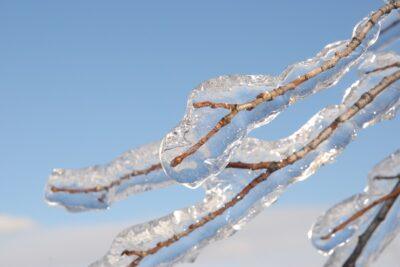|
Listen To The Article
|
Winter weather has arrived, and with it all the joys and excitement of the season. We have Christmas carols ringing, cookies baking, and snow falling.
The snow is pretty and coats the farmyard in a beautiful white blanket … and then it turns to ice. We slip and slide to feed and water the animals. Our animals skid and stumble on frozen ground, and sometimes injuries occur. Ice crusts around gate entryways and heavy traffic areas. Tending to homestead chores becomes a nightmare.
Lessen The Physical Labor
The first option for dealing with ice and snow buildup is simply physical labor. I can hear you sighing now, but bear with me. Get your shovel out and start scooping. While it may be tempting to wait until the end of a snowstorm to start shoveling, consider stepping outside every couple of hours during a heavier snowfall. If you do, shoveling will be relatively quick and kinder on your back and shoulders. Additionally, if you choose to put down a de-icing product, it will handle a thinner layer of snow more easily.
High traffic areas, like gateways and barnyards, often transform into skating rinks during cold weather. If you can’t pave these areas, consider putting down thick layers of gravel to combat the formation of icy mud pockets. I’ve seen horse pastures with deep ankle-twisting holes around the gates. Horses trample in the soft mud and when it freezes, it endangers both humans and livestock. If at all possible, pave or gravel these areas ahead of time. In case you can’t do this, consider blocking larger livestock from gated areas until the area has frozen solid.
If a part of your pasture or paddock becomes an ice sheet — especially on hilly areas — consider moving animals to another enclosure or bringing them into the barn. I’ve heard stories where animals have become trapped down at the bottom of pastures because they couldn’t gain the footing to climb the hill and humans couldn’t safely get down to them.
Also, evaluate your pasture for proper drainage, preferably before the large winter storms hit. Melting snow forms ice, so any way you can enhance rapid water drainage will help cut down on ice formation. Dig ditches and level areas to angle water runoff away from water troughs, sheds and feeding stations.
If you have to venture out into icy areas often, invest in a pair of traction cleats or shoe snow chains and carry a shovel and ice pick in your farm vehicles. You never know when it may be necessary to move some snow, but you can be guaranteed that you will need to at some point.
Traction Enhancers
Sometimes all you will need is a traction enhancer, especially once temperatures drop below 10-15 degrees Fahrenheit when salt no longer melts snow. Sand can be sprinkled liberally and its grittiness can give your shoes and farm equipment enough of a grip to make chores possible. The one downside to sand use is the danger of it clogging drains and sewers, so plan on cleaning it up in the spring. Gravel, non-clumping kitty litter and ashes are other options for increasing traction. Buy a couple of extra bags and store them in the back of your vehicles. The added weight can help tires grip the road better, and traction enhancers can come in handy if you slide off the road or path at some point.
Want The Best Chemical-Free, All-Natural Insecticide — For Your Garden AND Home?
Additionally, when ice forms, you may be able to take your tractor out and use it to break up the ice around water troughs and shed areas. Just practice farm safety and don’t operate your equipment if it endangers you.
Chemical De-Icers
No chemical de-icer is entirely livestock or environmentally friendly. If you need to use these products, be sure to store the products in animal- and child-proof containers, preferably locked in a shed or garage away. Here are three to consider:
1. Urea –
This is the most common ingredient in “pet-friendly” de-icing products. While it may not poison your pet, it is high in nitrogen and can burn plants and fields and encourage algal blooms in pools and waterways. Caley Chambers at PetPoisonHelpline.com said, “Ingestion of urea (by pets) usually leads to salivation and mild gastronintestinal irritation, but large ingestions may result in weakness, tremors, and methemoglobinemia.”
2. Magnesium Chloride –
This form of salt is preferable over the more common sodium chloride. It generally is less corrosive and safer for pets and livestock. Keep in mind, however, that this can damage concrete, so be careful where you spread it. Ingestion of Magnesium Chloride can cause gastrointestinal upset in pets and can be dangerous if eaten in large amounts. Pets and livestock may find its salty taste delectable, so use only in areas where animals don’t have free, un-supervised access.
3. Calcium Magnesium Acetate –
Acetate is considered less corrosive and damaging than regular salt. However, calcium salts can be very irritating to skin and paws. Every year, cats’ and dogs’ paws are burned by calcium salts lodging between their pads. Even if a pet never ventures outside, be aware that your boots will often pick up the salts and bring them indoors. Consider storing boots in a separate room or up above your pet’s reach. If an animal eats larger quantities, severe gastrointestinal upset can result, so be sure to store de-icers containing acetate securely and don’t spread them where livestock frequents.
Use them as sparingly as you can, and don’t be afraid to have your children help with shoveling. Enjoy your winter weather and stay safe!
How do you keep your farm or homestead free of dangerous ice? Share your tips in the section below:
 Off The Grid News Better Ideas For Off The Grid Living
Off The Grid News Better Ideas For Off The Grid Living






